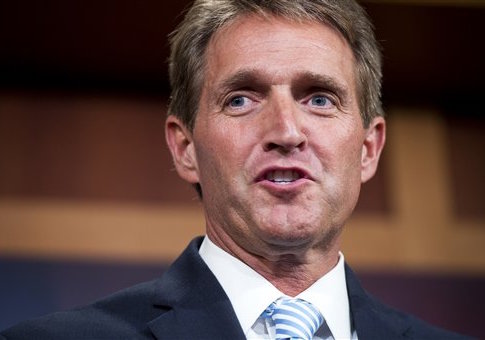Sen. Jeff Flake (R., Ariz.) released his first chronicle of government waste on Tuesday, exposing billions in egregious and unnecessary federal spending on everything from wine classes for minors to fight clubs for shrimp.
Wastebook: The Farce Awakens, starring "monkeys on treadmills, parties for hipsters, and sheep in microgravity," continues the tradition of retired Sen. Tom Coburn. The cover for the Star Wars themed report portrays Flake as the Luke Skywalker to Coburn’s Obi Wan.
"As a longtime admirer, former colleague, and friend, it is a great honor, heavy responsibility and awesome privilege to join others, like Senators James Lankford and John McCain, to try to carry forward the Coburn legacy of making those who spend accountable to those who pay tax dollars," Flake said.
No government agency was spared in Flake’s 286-page report that features 101 examples of waste, from the big ($100 billion in government-wide, improper payments) to the small ($20,000 to "celebrate the piñata" in Baltimore).
"Monkeys running in hamster balls on a treadmill. Zombies in the White House. Sheep in microgravity. Cartooning in India. A life-size Pac-Man game. Jazz lessons for robots. A cloud city on Venus!" Flake said, listing off the numerous examples of waste in the introduction to his report. "Despite the public ballyhooing over budget austerity, the government didn’t come up short on outlandish ways to waste money in 2015."
The monkey study cost taxpayers $1 million from the National Institutes of Health, an agency often cited for its wasteful spending. The project trained twelve marmoset monkeys in how to run on a treadmill, which caused some unfortunate animals to vomit and "defecate in their exercise ball."
Other examples included $50,000 from the State Department for a Do-It-Yourself festival in Moscow; $853,000 from the National Science Foundation for wine classes for minors; and $68,129 in food aid from the Department of Agriculture that was spent on a craft beer, wine, and spirits training program in Vietnam.
A $1.3 million National Science Foundation study tried to figure out if a koozie does in fact keep a beer cold (it does), and a $780,000 National Institute of Drug Abuse study attempted to determine if college students can get addicted to pizza. The results were inconclusive.
The Department of Transportation spent $77,000 on anti-drunk driving PSAs where fake drunk men criticize women’s looks.
Ads included one drunk man telling a woman "plastic surgery would do wonders for your jaw structure and definitely your nose," and another saying she would "be cuter with the lights off."
The report features several examples of frivolous government spending first uncovered by the Washington Free Beacon, including $5 million to throw "commune" dance parties for hipsters to encourage them to quit smoking.
Pamela Ling, a professor at UCSF School of Medicine and former contestant on MTV’s "The Real World," is running the project, which pays hipsters $5 a week and sells anti-neocon propaganda.
Flake found the anti-smoking campaign is not working as planned.
"One of those who joined the ‘Commune quit group’ is smoking again and admits, ‘I did it for the money,’" the report said.
Other Free Beacon stories highlighted in the report included $17,500 for college students to wear fat suits for "weight sensitivity training"; $200,113 to develop a fat detector that guesses a person’s body mass index by looking at their face; and $15,000 from the Environmental Protection Agency to create a device that monitors how long hotel guests spend in the shower.
Flake’s report detailed that researchers were awarded $2.6 million to try to craft the perfect tweet. Their advice to get more retweets? Add "Plz retweet."
A $707,000 study started a "shrimp fight club" that included 34 bouts with mantis shrimp, and $79,000 was spent on a "sing along brunch party" with 80 people singing tunes from Annie to promote a farmer’s market.
Tailgaiting kits with a koozie, apron, and food thermometer were provided for University of Nebraska Cornhuskers football games through a $5 million Department of Agriculture grant to promote food safety. Part of a $1.2 million National Science Foundation grant created a life size Pac-Man game on a basketball court. Another $899,000 was spent studying "the social interactions of guppies."
NASA spent $1.2 million testing microgravity on sheep, which they admitted was a "niche" project. The purpose of the study was to learn about bone development in outer space, though NASA has "long known astronauts lose bone density in space."
Readers might question why the Department of Housing and Urban Development gave $210,000 to a dog clothing company that makes a dog vest with an "exclusive double Velcro closure."
In what Flake said sounded like the plot of a John Hughes movie, the National Science Foundation spent $276,194 to figure out how unattractive people find attractive mates. The study found that the answer was to be friends for a while first.
A $2.5 million Pentagon project created a creepy robot lobby greeter. "With a plastic mask, wig and long metal fingers, the greeter has a creepy appearance resembling a hybrid of horror movie villains Michael Myers from Halloween and Freddy Krueger from A Nightmare on Elm Street," Flake said.
"Probably not the smiling face you would hope to be greeted by," he said.
In order to make it in the Wastebook some or all of the spending must have occurred in fiscal year 2015.
"Washington equates caring with the amount of dollars spent," Flake concluded. "But there has been an awakening in the farce."
"When the same group who created the problems are the same ones trusted to fix them, what amount of dollars and cents can make up for the lack of common sense in how the money is spent?"
